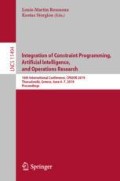Abstract
The resolution of some Mixed-Integer Linear Programming (MILP) problems still presents challenges for state-of-the-art optimization solvers and may require hours of computations, so that a time-limit to the resolution process is typically provided by a user. Nevertheless, it could be useful to get a sense of the optimization trends after only a fraction of the specified total time has passed, and ideally be able to tailor the use of the remaining resolution time accordingly, in a more strategic and flexible way. Looking at the evolution of a partial branch-and-bound tree for a MILP instance, developed up to a certain fraction of the time-limit, we aim to predict whether the problem will be solved to proven optimality before timing out. We exploit machine learning tools, and summarize the development and progress of a MILP resolution process to cast a prediction within a classification framework. Experiments on benchmark instances show that a valuable statistical pattern can indeed be learned during MILP resolution, with key predictive features reflecting the know-how and experience of field’s practitioners.
Access this chapter
Tax calculation will be finalised at checkout
Purchases are for personal use only
References
Achterberg, T., Berthold, T., Hendel, G.: Rounding and propagation heuristics for mixed integer programming. In: Klatte, D., Lüthi, H.J., Schmedders, K. (eds.) Operations Research Proceedings 2011, pp. 71–76. Springer, Heidelberg (2012). https://doi.org/10.1007/978-3-642-29210-1_12
Achterberg, T., Wunderling, R.: Mixed integer programming: analyzing 12 years of progress. In: Jünger, M., Reinelt, G. (eds.) Facets of Combinatorial Optimization, pp. 449–481. Springer, Heidelberg (2013). https://doi.org/10.1007/978-3-642-38189-8_18
Belov, G., Esler, S., Fernando, D., Bodic, P.L., Nemhauser, G.L.: Estimating the size of search trees by sampling with domain knowledge. In: Proceedings of the Twenty-Sixth International Joint Conference on Artificial Intelligence, IJCAI 2017, pp. 473–479 (2017). https://doi.org/10.24963/ijcai.2017/67
Bengio, Y., Lodi, A., Prouvost, A.: Machine learning for combinatorial optimization: a methodological tour d’horizon (2018). Preprint: arXiv:1811.06128
Berthold, T., Hendel, G., Koch, T.: From feasibility to improvement to proof: three phases of solving mixed-integer programs. Optim. Methods Softw. 33(3), 499–517 (2017). https://doi.org/10.1080/10556788.2017.1392519
Bonami, P., Lodi, A., Zarpellon, G.: Learning a classification of mixed-integer quadratic programming problems. In: van Hoeve, W.-J. (ed.) CPAIOR 2018. LNCS, vol. 10848, pp. 595–604. Springer, Cham (2018). https://doi.org/10.1007/978-3-319-93031-2_43
Breiman, L.: Random forests. Mach. Learn. 45(1), 5–32 (2001). https://doi.org/10.1023/A:1010933404324
Cornuéjols, G., Karamanov, M., Li, Y.: Early estimates of the size of branch-and-bound trees. INFORMS J. Comput. 18(1), 86–96 (2006). https://doi.org/10.1287/ijoc.1040.0107
Cortes, C., Vapnik, V.: Support-vector networks. Mach. Learn. 20(3), 273–297 (1995). https://doi.org/10.1023/A:1022627411411
CPLEX. http://www-01.ibm.com/software/commerce/optimization/cplex-optimizer/index.html. Accessed 2018
Deshpande, M., Karypis, G.: Evaluation of techniques for classifying biological sequences. In: Chen, M.-S., Yu, P.S., Liu, B. (eds.) PAKDD 2002. LNCS (LNAI), vol. 2336, pp. 417–431. Springer, Heidelberg (2002). https://doi.org/10.1007/3-540-47887-6_41
Fischetti, M., Fraccaro, M.: Using OR + AI to predict the optimal production of offshore wind parks: a preliminary study. In: Sforza, A., Sterle, C. (eds.) Optimization and Decision Science: Methodologies and Applications. Springer Proceedings in Mathematics & Statistics, vol. 217, pp. 203–211. Springer, Cham (2017). https://doi.org/10.1007/978-3-319-67308-0_21
Geurts, P., Ernst, D., Wehenkel, L.: Extremely randomized trees. Mach. Learn. 63(1), 3–42 (2006). https://doi.org/10.1007/s10994-006-6226-1
Gomory, R.: An algorithm for the mixed integer problem. Technical report RM-2597, The Rand Corporation (1960)
Goodfellow, I., Bengio, Y., Courville, A.: Deep Learning. MIT Press, Cambridge (2016). http://www.deeplearningbook.org
Hutter, F., Hoos, H.H., Leyton-Brown, K.: Automated configuration of mixed integer programming solvers. In: Lodi, A., Milano, M., Toth, P. (eds.) CPAIOR 2010. LNCS, vol. 6140, pp. 186–202. Springer, Heidelberg (2010). https://doi.org/10.1007/978-3-642-13520-0_23
Hutter, F., Xu, L., Hoos, H.H., Leyton-Brown, K.: Algorithm runtime prediction: methods & evaluation. Artif. Intell. 206, 79–111 (2014). https://doi.org/10.1016/j.artint.2013.10.003
Khalil, E.B., Dilkina, B., Nemhauser, G., Ahmed, S., Shao, Y.: Learning to run heuristics in tree search. In: 26th International Joint Conference on Artificial Intelligence (IJCAI) (2017)
Klotz, E., Newman, A.M.: Practical guidelines for solving difficult mixed integer linear programs. Surv. Oper. Res. Manag. Sci. 18(1), 18–32 (2013)
Knuth, D.E.: Estimating the efficiency of backtrack programs. Math. Comput. 29(129), 122–136 (1975)
Koch, T., et al.: MIPLIB 2010. Math. Program. Comput. 3(2), 103–163 (2011). https://doi.org/10.1007/s12532-011-0025-9
Kruber, M., Lübbecke, M.E., Parmentier, A.: Learning when to use a decomposition. In: Salvagnin, D., Lombardi, M. (eds.) CPAIOR 2017. LNCS, vol. 10335, pp. 202–210. Springer, Cham (2017). https://doi.org/10.1007/978-3-319-59776-8_16
Land, A., Doig, A.: An automatic method of solving discrete programming problems. Econometrica 28, 497–520 (1960)
Lane, T., Brodley, C.E.: Temporal sequence learning and data reduction for anomaly detection. ACM Trans. Inf. Syst. Secur. 2(3), 295–331 (1999). https://doi.org/10.1145/322510.322526
Larsen, E., Lachapelle, S., Bengio, Y., Frejinger, E., Lacoste-Julien, S., Lodi, A.: Predicting solution summaries to integer linear programs under imperfect information with machine learning (2018). Preprint: arXiv:1807.11876
Lodi, A.: Mixed integer programming computation. In: Jünger, M., et al. (eds.) 50 Years of Integer Programming 1958–2008, pp. 619–645. Springer, Heidelberg (2009). https://doi.org/10.1007/978-3-540-68279-0_16
Lodi, A., Tramontani, A.: Performance variability in mixed-integer programming, Chap. 1, pp. 1–12. INFORMS (2013). https://doi.org/10.1287/educ.2013.0112
Lodi, A., Zarpellon, G.: On learning and branching: a survey. TOP 25(2), 207–236 (2017). https://doi.org/10.1007/s11750-017-0451-6
Louppe, G.: Understanding random forests: from theory to practice. Ph.D. thesis, October 2014. https://doi.org/10.13140/2.1.1570.5928
Mittelmann, H.D.: MILPlib (2018). http://plato.asu.edu/ftp/milp/. Accessed 2018
Pedregosa, F., et al.: Scikit-learn: machine learning in Python. J. Mach. Learn. Res. 12, 2825–2830 (2011)
Sebastiani, F.: Machine learning in automated text categorization. ACM Comput. Surv. 34(1), 1–47 (2002). https://doi.org/10.1145/505282.505283
Xing, Z., Pei, J., Keogh, E.: A brief survey on sequence classification. ACM SIGKDD Explor. Newsl. 12(1), 40–48 (2010). https://doi.org/10.1145/1882471.1882478
Author information
Authors and Affiliations
Corresponding author
Editor information
Editors and Affiliations
Rights and permissions
Copyright information
© 2019 Springer Nature Switzerland AG
About this paper
Cite this paper
Fischetti, M., Lodi, A., Zarpellon, G. (2019). Learning MILP Resolution Outcomes Before Reaching Time-Limit. In: Rousseau, LM., Stergiou, K. (eds) Integration of Constraint Programming, Artificial Intelligence, and Operations Research. CPAIOR 2019. Lecture Notes in Computer Science(), vol 11494. Springer, Cham. https://doi.org/10.1007/978-3-030-19212-9_18
Download citation
DOI: https://doi.org/10.1007/978-3-030-19212-9_18
Published:
Publisher Name: Springer, Cham
Print ISBN: 978-3-030-19211-2
Online ISBN: 978-3-030-19212-9
eBook Packages: Computer ScienceComputer Science (R0)

